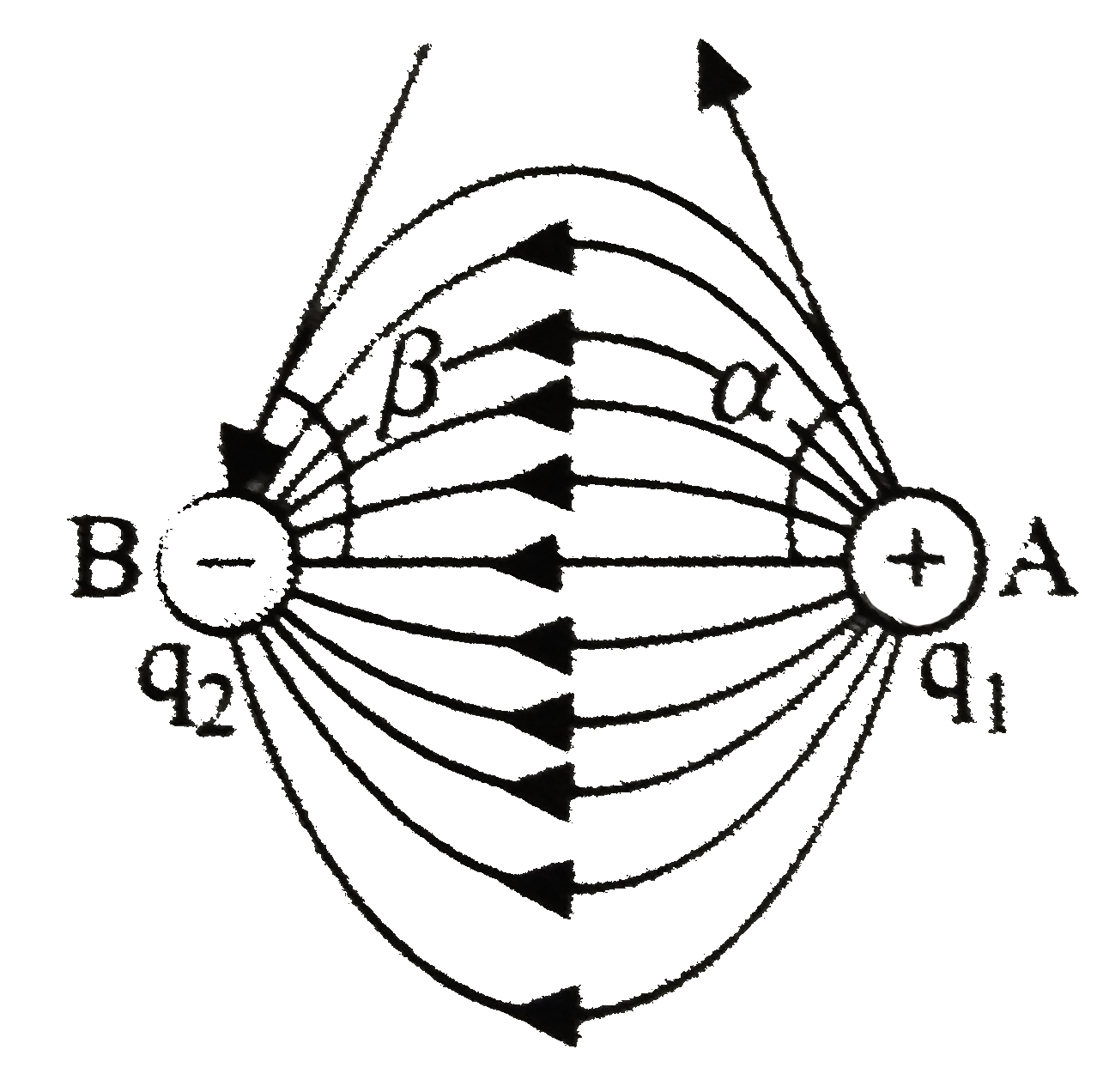Two point charges +Q1and−Q2 are placed at A and B respectively. A line of force emanates from Q1 at an angle θ with the line joining A and B. At what angle will it terminate at B ?

We know that number of lines of force emerge is proportional to magnitude of the charge. The field lines emanating from Q1, spread out equally in all directions. The number of field lines or flux through cone of half angle θ is Q14π2π(1−cosθ).
Similarly the number of lines of force terminating on −Q2 at an angle ϕ is Q24π2π(1−cosϕ). The total lines of force emanating from Q1 is equal to the total lines of force terminating on Q2
⇒Q14π2π(1−cosθ)=Q24π2π(1−cosϕ)orQ12(1−cosθ)=Q22(1−cosϕ)
Q1sin2θ/2=Q2sin2ϕ/2
sinϕ/2=√Q1Q2sinθ/2⇒ϕ=2sin−1{√Q1Q2sinθ/2}
Topper's Solved these Questions
- ELECTRIC CHARGES AND FIELDSBOOK - AAKASH SERIESCHAPTER - ELECTRIC CHARGES AND FIELDSEXERCISE - Assess Your Self
13 Videos
- ELECTRIC CHARGES AND FIELDSBOOK - AAKASH SERIESCHAPTER - ELECTRIC CHARGES AND FIELDSEXERCISE - Exercise-I
80 Videos
- DUAL NATURE OF RADIATION AND MATTERBOOK - AAKASH SERIESCHAPTER - DUAL NATURE OF RADIATION AND MATTEREXERCISE - PRACTICE EXERCISEX
44 Videos
- ELECTRIC FIELD AND POTENTIALBOOK - AAKASH SERIESCHAPTER - ELECTRIC FIELD AND POTENTIALEXERCISE - PROBLEMS (LEVEL-II)
32 Videos
Similar Questions
Two charges+q1 and −q2 are placed at A and B respectively. A line of force emanates from q1 at an angle α with the line AB. At what angle will it terminate at −q2 ?

View SolutionTwo charges+q1 and −q2 are placed at A and B respectively. A line of force emanates from q1 at an angle α with the line AB. At what angle will it terminate at −q2 ?

View Solution
Knowledge Check
Two points charge q1 and q2(=q1/2) are placed at points A(0,1) and B(1,0) as shown in the figure.The electric field vector at point P(1,1) makes an angle q with the x-axis ,then the angle q is
 Atan−1(12)Btan−1(14)Ctan−1(1)Dtan−1(0)
Atan−1(12)Btan−1(14)Ctan−1(1)Dtan−1(0)Two charge Q1 and Q2 are placed at the points A and B having separation r lying inside and outside the unchanged conducting shell. The force on Q1 is F and that on Q2 is f.Then
AF=0BF=14πε0Q1Q2r2Cf=14πε0Q1Q2r2Df=0Two point charges +4q and +q are placed 30cm apart. At what point on the line joining them is the electric field zero
A15 cm from charge qB20 cm from charge 4 qC7.5 cm from charge qD5cm from charge q
Two point charges +q1 and −q2 are placed at A and B respectvely. An electric line of force emerges from q1 making an angle α=60∘ with line AB and terminates as −q2 making an angle of 90∘ with line AB.
(a). Find ∣∣∣q1q2∣∣∣ ltbr> (b). Find the maximum value of angle α at which a line emitted from q1 terminates on charge q2.

View SolutionTwo point charges Q and q are placed at distance r and r2 respectively alogn a straigt line from a third charge 4q. If q is in equilibrium determine Qq.
View SolutionTwo point charges+ q and-q are placed at distanced apart. What are the points at which the resultant field is parallel to the line joining the two charges ?
View Solution(a) An electric dipole of dipole moment →p is placed in a uniform electric field →E at an angle θ with it. Derive the expression for torque (→τ) acting on it. Find the orientation of the dipole relative to the electric field for which torque on it is (i) maximum, and (ii) half of maximum.
(b) Two point charges q1=+1μC and q2=+4μC are placed 2 m apart in air. At what distance from q1 along the line joining the two charges, will the net electric field be zero ?
View SolutionTwo point charges +4q and +q are placed 30cm apart. At what point on the line joining them is the electric field zero
View Solution
